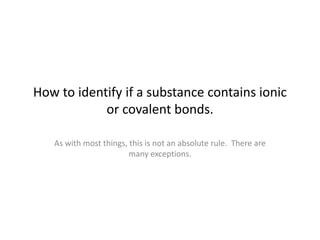Unit 5 2 determining if a compound is ionic or covalent
•Download as PPTX, PDF•
3 likes•7,637 views
jwallach
Report
Share
Report
Share

Recommended
Recommended
More Related Content
What's hot
What's hot (20)
2 6 unit conversion - mole conversions - atom and molecule to mole

2 6 unit conversion - mole conversions - atom and molecule to mole
Viewers also liked
Viewers also liked (8)
Similar to Unit 5 2 determining if a compound is ionic or covalent
Similar to Unit 5 2 determining if a compound is ionic or covalent (20)
Acid base reactions BY MUHAMMAD FAHAD ANSARI 12IEEM 14

Acid base reactions BY MUHAMMAD FAHAD ANSARI 12IEEM 14
More from jwallach
More from jwallach (9)
Recently uploaded
Recently uploaded (20)
Connaught Place, Delhi Call girls :8448380779 Model Escorts | 100% verified

Connaught Place, Delhi Call girls :8448380779 Model Escorts | 100% verified
Introduction,importance and scope of horticulture.pptx

Introduction,importance and scope of horticulture.pptx
9654467111 Call Girls In Raj Nagar Delhi Short 1500 Night 6000

9654467111 Call Girls In Raj Nagar Delhi Short 1500 Night 6000
SAMASTIPUR CALL GIRL 7857803690 LOW PRICE ESCORT SERVICE

SAMASTIPUR CALL GIRL 7857803690 LOW PRICE ESCORT SERVICE
9999266834 Call Girls In Noida Sector 22 (Delhi) Call Girl Service

9999266834 Call Girls In Noida Sector 22 (Delhi) Call Girl Service
Module for Grade 9 for Asynchronous/Distance learning

Module for Grade 9 for Asynchronous/Distance learning
Pests of mustard_Identification_Management_Dr.UPR.pdf

Pests of mustard_Identification_Management_Dr.UPR.pdf
FAIRSpectra - Enabling the FAIRification of Spectroscopy and Spectrometry

FAIRSpectra - Enabling the FAIRification of Spectroscopy and Spectrometry
High Class Escorts in Hyderabad ₹7.5k Pick Up & Drop With Cash Payment 969456...

High Class Escorts in Hyderabad ₹7.5k Pick Up & Drop With Cash Payment 969456...
Call Girls Alandi Call Me 7737669865 Budget Friendly No Advance Booking

Call Girls Alandi Call Me 7737669865 Budget Friendly No Advance Booking
Unit 5 2 determining if a compound is ionic or covalent
- 1. How to identify if a substance contains ionic or covalent bonds. As with most things, this is not an absolute rule. There are many exceptions.
- 2. Purpose • The type of bonding present in a substance greatly influences its properties. Additionally, it will determine how we name a substance. For example, the systematic name of H2O is dihydrogen monoxide, while the systematic name of Li2O is lithium oxide – one has covalent bonds and uses the prefix di- and the other has ionic bonds and does not use prefixes. For these reasons, we need to be able to identify if a compound presented to us contains ionic or covalent bonds.
- 3. If the substance contains a metal and one or more non-metals, it is likely ionic. • Some examples of ionic compounds – NaCl • Sodium is a metal and chlorine is a non-metal – Fe(NO3)2 • iron is a metal and nitrogen and oxygen are non-metals – ZnSO4 • Zinc is a metal and sulfur and oxygen are non-metals – MgS • Magnesium is a metal and sulfur is a non-metal
- 4. If the substance contains all non-metals, it is likely covalent. • Some examples of covalent compounds – HCl – C6H12O6 – CS2 – H2O
- 5. Important exception – ionic compounds containing ammonium (NH4 +) do not have a metal. • These compounds contain all non-metals; however, they contain ionic bonds. The polyatomic ion NH4 + is in the place of the metal. – NH4Cl – (NH4)2SO4
- 6. Pause and Practice • Identify if each of the following is likely to have ionic bonds or covalent bonds – FeS – SO2 – MgCO3 – NH4Cl – CH4
- 7. Pause and Practice - Answers • Identify if each of the following is likely to have ionic bonds or covalent bonds – FeS • Ionic – iron is a metal and sulfur is a non-metal – SO2 • Covalent – both sulfur and oxygen are non-metals – MgCO3 • Ionic – magnesium is a metal and carbon and oxygen are non-metals – NH4Cl • Ionic – ammonium is an exception to the metal rule and chlorine is a non-metal – CH4 • Covalent – both carbon and hydrogen are non-metals